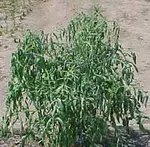so lucky
Garden Master
Kassaundras problem is not an herbicide. There is absolutely no indication or symptoms of herbicidal contamination. The symptoms and circumstances also do not point to water wilt. There is, however, every indication of bacterial infection. Without seeing the roots, I can only speculate. It could also be root knot nematodes, but it's unlikely since the onset of symptoms was so sudden. The symptoms she described are textbook Bacterial Wilt. Dipping the stem in a glass of water will tell the tale, if it's not too late.
@MontyJ, what will dipping the stem in a glass of water show? How soon does it need to be done?

